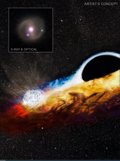Oct. 10 () –
The X-ray Observatory NASA Chandra and other telescopes have identified a supermassive black hole that has destroyed a star and now it’s using that stellar debris to hit another star or a smaller black hole.
This research helps connect two cosmic mysteries and provides information about the environment surrounding some of the largest types of black holes, as reported by NASA.
In 2019, an optical telescope in California detected a burst of light that astronomers later categorized as a “tidal disruption event” or TDE, for its acronym in English. These are cases in which black holes destroy stars if they get too close using their powerful tidal forces. Astronomers named this TDE AT2019qiz.
Meanwhile, scientists also were following cases of other types of cosmic phenomena occasionally observed throughout the Universe. These were short, regular bursts of X-rays that occurred near supermassive black holes. Astronomers called these events “quasiperiodic eruptions” or QPEs.
This latest study gives scientists evidence that TDEs and QPEs are likely connected. Researchers believe that QPEs arise when an object collides with the disk left after the TDE. Although there may be other explanations, the study authors propose that this is the source of at least some QPE.
In 2023, astronomers used both Chandra and Hubble to simultaneously study debris left after the tidal disturbance ended. The Chandra data were obtained during three different observations, each separated by about 4 or 5 hours. The total exposure of about 14 hours of Chandra time revealed only a weak signal in the first and last fragments, but a very strong signal in the middle observation.
From there, researchers used NASA’s Neutron Star Interior Composition Explorer (NICER) to frequently observe AT2019qiz for repeating X-ray bursts.
NICER data showed that AT2019qiz erupts approximately every 48 hours. Observations from NASA’s Neil Gehrels Swift Observatory and India’s AstroSat telescope solidified the finding.
Hubble’s ultraviolet data, obtained at the same time as Chandra observations, allowed scientists to determine the size of the disk surrounding the supermassive black hole.
They found that the disk had grown enough that if any object was orbiting the black hole and took a week or less to complete one orbit, it would collide with the disk and cause flares.
This result has implications for the search for more quasi-periodic eruptions associated with tidal disturbances. Finding more of these would allow astronomers to measure the prevalence and distances of objects in close orbits around supermassive black holes. Some of these may be excellent targets for future gravitational wave observatories. .















![[Img #74800]](https://thelatestnews.world/wp-content/uploads/2025/01/What-makes-the-HONOR-store-a-great-choice-for-buyers-300x200.jpg)
Add Comment